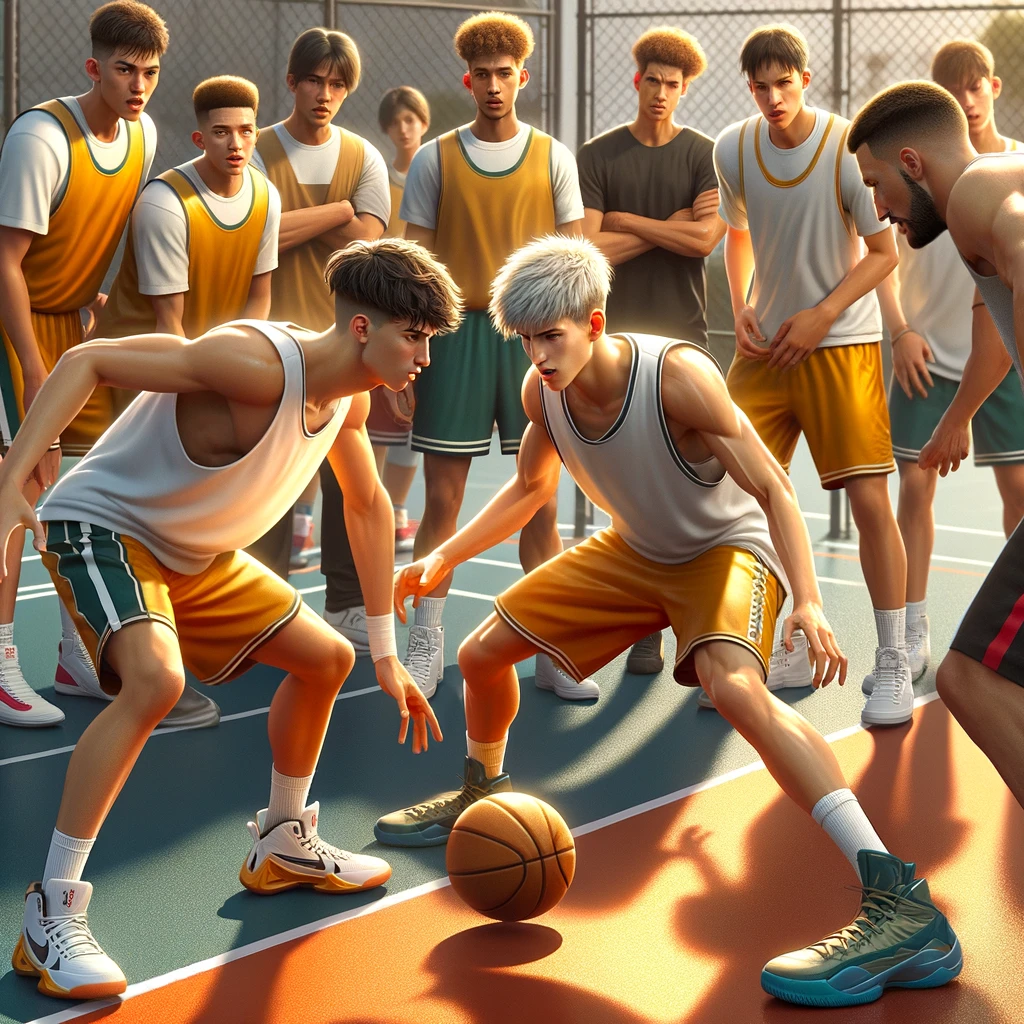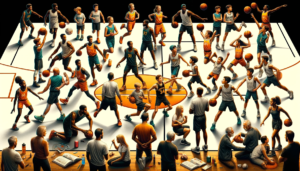
A note to our valued team:
Gang,
Obviously we are facing some effort and motivation challenges this weekend. This is inevitable during the course of a long select basketball season and I have had several teams deal with this specifically on Memorial Day Weekend.
On the other hand, we didn’t see our opponents struggle with early morning game or other challenges.
So let’s disengage a bit as individuals and be curious for 10 minutes about the science of intrinsic and extrinsic motivation in basketball and off the court and how it relates to sustained effort, happiness, and success for you.
I care about each of you as individuals as well as our team culture, and I think we can use this to our mutual benefit.
1. Understanding Intrinsic Motivation in Basketball
- Definition: Intrinsic motivation refers to engaging in activities for the inherent joy and satisfaction they provide. Would you play basketball for the love alone? Without parents, trainers, college resume aspirations?
- Examples: Playing basketball for the love of the game, personal growth, the sweat and endorphins and the pleasure of mastering new skills. This would be most closely associated with Real Run in our gym.
2. Understanding Extrinsic Motivation in Basketball
- Definition: Extrinsic motivation involves performing activities to earn rewards or avoid punishments.
- “Jump stop and pass to the outside hand successfully and we don’t need to run 17s.”
- “Make 30 threes each team in 5 minutes and we can scrimmage 30 minutes with music.”
- Examples: Playing basketball for trophies, scholarships, or approval from coaches and peers. People pleasing… is also a factor here. Do you want validation to come only from fitting a culture of hard work that others extrinsically establish or do you feel self satisfaction from knowing win or lose… you gave it everything?
3. Benefits of Intrinsic Motivation On the Court
- Sustained Passion: Players motivated by intrinsic factors are more likely to maintain a long-term passion for the game. You can’t bring my intensity and fire with you to your school team. Life is hard… and passion with intrinsic motivation can be a fuel that is highly underrated for your success and happiness in overcoming obstacles. Passion | Purpose | Power are themes in our gym… and how to optimize for them is obviously a little different for all of you.
- Resilience: Intrinsically motivated players tend to be more resilient and persistent in the face of challenges.
4. Benefits of Intrinsic Motivation Off the Court
- Personal Growth: Focusing on internal satisfaction promotes continuous personal development and learning.
- Life Satisfaction: Activities driven by intrinsic motivation contribute to overall life satisfaction and happiness.
- How can we do that while still not letting the joy of today pass us by? Love ourselves for the player we are today. Love ourselves for wanting more despite that always coming with ups and downs, and laugh and cry a bit along the journey.
5. Limitations of Extrinsic Motivation On the Court
- Short-Term Focus: Extrinsic rewards can lead to a short-term focus and reliance on external validation. I have seen a shift in the ability to handle, and the desire of players for change thru coaching in the game. Successful employers have also noted the change in the workplace. Extrinsic motivation may be at an all time weakness as a tool.
- Burnout Risk: Overemphasis on external rewards can increase the risk of burnout and loss of interest. Many of you are coming off intense finals. Some of you are in double book basketball classes. Some need time off from a game they like a lot… but may not be all in for. Some just need a recharge couple of weeks.
6. Limitations of Extrinsic Motivation Off the Court
- Dependency on Feedback: Relying heavily on external feedback from coaches and superiors can hinder personal growth and self-confidence. Basketball coaches have ceilings they must put on players. One ball. Only 5 players on the court at a time. Coaches need to win to keep their jobs typically. Culture matters too. But ceilings and accountability don’t always foster growth mindset. Like… which comes first… your green light to take threes or your ability to grow and experiment into earning that green light.
- Reduced Autonomy: Extrinsic motivation can diminish a player’s sense of autonomy and control over their own development.
7. Desire for Less Feedback
 Self-Reliance: Developing intrinsic motivation reduces the need for constant feedback from coaches, fostering greater self-reliance and self-assessment. Don’t like feedback loop and correction? Do your job. If you get annoyed hearing a coach talk about jump stops, rip thrus, and fake a pass to make a pass… what do you own? Where can you rely on self awareness and internal dialogue/coaching to reduce extrinsic motivation communication?
Self-Reliance: Developing intrinsic motivation reduces the need for constant feedback from coaches, fostering greater self-reliance and self-assessment. Don’t like feedback loop and correction? Do your job. If you get annoyed hearing a coach talk about jump stops, rip thrus, and fake a pass to make a pass… what do you own? Where can you rely on self awareness and internal dialogue/coaching to reduce extrinsic motivation communication? - Internal Drive: Players with strong intrinsic motivation are driven by internal goals and standards, leading to more self-directed improvement. I see many of you so powerful in many areas of your life in this regard. Academics definitely comes to mind. Other areas more individual to each player as well.
8. Enhancing Intrinsic Motivation
- Goal Setting: Encourage players to set personal, meaningful goals that align with their passions and interests. “Today I want to play at a 9 or 10 in effort. That looks like running the floor full speed on defense, staying in motion on offense, committing to turns on defense, and rebounding like my life depended on it.
- Self-Reflection: Promote regular self-reflection to help players recognize and appreciate their intrinsic motivations. “What are the physiological responses to anxiety that I must master on the court today?” “Why am I great today?’
9. Balancing Intrinsic and Extrinsic Motivation
- Healthy Integration: While intrinsic motivation should be the primary driver, a healthy balance with extrinsic rewards can enhance motivation without dependence.
- Recognition and Rewards: Use extrinsic rewards as a complement to, rather than a replacement for, intrinsic motivation. We all need coaching. Most people need a boss at work. We all can enjoy a balance… now figure out what you want to own. The ratio is a bit different for all of us, can be situational to passion level, and also can be related to inherent personality ability to receive candor, push ourselves, etc. But the needle can be moved by you and your willingness to change.
10. Long-Term Success and Happiness
- Sustainable Engagement: Intrinsic motivation leads to sustainable engagement in basketball and other activities, ensuring long-term success and happiness.
- Holistic Development: Fostering intrinsic motivation supports holistic development, including emotional, psychological, and social well-being.

By understanding and valuing intrinsic motivation, Fierce basketball players can develop a deeper love for the game, become more self-reliant, and achieve greater overall success and happiness both on and off the court. I would also assert it is your best chance to find your passions, get more playing time, and be the best version of you that you can look in the mirror and smile at. Because you are all awesome and all deserve that.
So who wants to try playing at a 8-10 level of effort today? Then compare how it feels to what I saw as 3-5s for the most part yesterday? I would tune into that. How does effort make me feel? Intrinsic. Let’s Go!
Statistics on Basketball Intrinsic and Extrinsic Motivation for Those Who Want to Dive Deeper
Here are 10 relevant statistics on the roles of extrinsic and intrinsic motivation in basketball success and happiness, cited from the provided search results:
1. A majority of college male basketball players participate for intrinsic reasons more than extrinsic reasons, according to a study of 12 players.[1]
2. Players with higher intrinsic motivation and task orientation scores participate in basketball because they desire and enjoy the satisfaction of learning and developing new skills.[1]
3. Players with higher extrinsic motivation scores tend to experience greater a motivation (lack of motivation) compared to those with higher intrinsic motivation.[1]
4. Verbal aggression from a coach had a positive correlation with extrinsic motivation in a study of 180 Greek teen basketball athletes.[2]
5. Participation in organized after-school sports is an important factor related to students’ competency and happiness in physical education.[2]
6. Among 1,258 elite youth athletes in the USA, key motivating factors included fun, socializing, competition opportunities, and the thrill of play.[2]
7. In a study of 256 female high school basketball players in Korea, motivation related to skill development, fulfillment, amusement and health had a positive effect on task-goal orientation.[3]
8. The same study found motivation for skill development, accomplishment and health was associated with greater self-goal orientation among the players.[3]
9. In a study comparing intrinsic and extrinsic motivation groups, the extrinsically motivated group shooting for awards 3 times a week had 6.9 percentage points higher free throw percentage in games compared to the intrinsically motivated group.[4]
10. A Spanish study of 180 young basketball players found a positive relationship between perceived performance and intrinsic motivation.[5]
Citations:
[1] https://openriver.winona.edu/cgi/viewcontent.cgi?article=1003&context=leadershipeducationcapstones
[2] https://soar.suny.edu/bitstream/handle/20.500.12648/4036/pes_synthesis/94/fulltext%20%281%29.pdf?
[3]https://www.ncbi.nlm.nih.gov/pmc/articles/PMC8819225/
[4] https://commons.und.edu/cgi/viewcontent.cgi?article=4982&context=theses
[5] https://www.ncbi.nlm.nih.gov/pmc/articles/PMC7767293/

 One-on-one attention in private basketball training ensures focused individual skill enhancement through personalized coaching and tailored strategies, maximizing the player’s potential for significant improvement.
One-on-one attention in private basketball training ensures focused individual skill enhancement through personalized coaching and tailored strategies, maximizing the player’s potential for significant improvement. The cost of private basketball training should be considered as an investment in individual development and skill enhancement, ensuring informed decisions based on the value of personalized coaching and dedicated attention.
The cost of private basketball training should be considered as an investment in individual development and skill enhancement, ensuring informed decisions based on the value of personalized coaching and dedicated attention. Group dynamics play a vital role in small group personalized basketball training, fostering a collaborative environment that enhances skills collectively, promoting camaraderie and community building within the training context. The questions is, when is a small group too big? I think that depends on the coach and also the coachability of the players. For me, it’s 5 players that allow me to personalized the training to their individualized needs.
Group dynamics play a vital role in small group personalized basketball training, fostering a collaborative environment that enhances skills collectively, promoting camaraderie and community building within the training context. The questions is, when is a small group too big? I think that depends on the coach and also the coachability of the players. For me, it’s 5 players that allow me to personalized the training to their individualized needs. Individualized attention in private basketball training ensures dedicated coaching and progress assessment, enabling players to receive exclusive guidance and focused development tailored to their unique skills and performance goals.
Individualized attention in private basketball training ensures dedicated coaching and progress assessment, enabling players to receive exclusive guidance and focused development tailored to their unique skills and performance goals.
 Comprehensive Skill Improvement: Advanced AR platforms provide a holistic approach to skill development, encompassing shooting, dribbling, passing, and defensive tactics. For example, HomeCourt’s AR technology offers a detailed analysis of a player’s shooting form, dribble speed, and ball-handling skills, enabling a comprehensive improvement plan tailored to individual needs.
Comprehensive Skill Improvement: Advanced AR platforms provide a holistic approach to skill development, encompassing shooting, dribbling, passing, and defensive tactics. For example, HomeCourt’s AR technology offers a detailed analysis of a player’s shooting form, dribble speed, and ball-handling skills, enabling a comprehensive improvement plan tailored to individual needs. Research and Select Suitable AR and VR Training Apps: Begin by exploring available AR and VR basketball training apps. Consider factors like features, user reviews, and compatibility with your devices.
Research and Select Suitable AR and VR Training Apps: Begin by exploring available AR and VR basketball training apps. Consider factors like features, user reviews, and compatibility with your devices.

 For marketing purposes, dynamic and high-quality basketball images help training companies to engage with their audience more effectively. These photos are used in brochures, websites, social media, and advertising campaigns to convey the excitement and professionalism of their training programs.
For marketing purposes, dynamic and high-quality basketball images help training companies to engage with their audience more effectively. These photos are used in brochures, websites, social media, and advertising campaigns to convey the excitement and professionalism of their training programs. Basketball stock photography can significantly enhance social media marketing by providing visually engaging content that attracts and retains audience attention. Effective use of these images can convey energy,
Basketball stock photography can significantly enhance social media marketing by providing visually engaging content that attracts and retains audience attention. Effective use of these images can convey energy,  Yes, amateur photographers can sell basketball stock photography, provided they produce high-quality, unique images that meet stock photo websites’ standards. Focusing on capturing unique angles, moments, and expressions can make your photos stand out. Before selling, ensure you understand and adhere to legal requirements, including model and property releases if applicable.
Yes, amateur photographers can sell basketball stock photography, provided they produce high-quality, unique images that meet stock photo websites’ standards. Focusing on capturing unique angles, moments, and expressions can make your photos stand out. Before selling, ensure you understand and adhere to legal requirements, including model and property releases if applicable.
 The allure of playing time can often overshadow the importance of skill development. It’s essential to shift the focus from the quantity of time spent on the court to the quality of skills being honed. Encourage your child to embrace practices as opportunities for growth, focusing on areas that need improvement. This mindset instills a work ethic that values effort and persistence, crucial traits for both athletic and personal development.
The allure of playing time can often overshadow the importance of skill development. It’s essential to shift the focus from the quantity of time spent on the court to the quality of skills being honed. Encourage your child to embrace practices as opportunities for growth, focusing on areas that need improvement. This mindset instills a work ethic that values effort and persistence, crucial traits for both athletic and personal development.
 When conflicts arise, address them constructively and seek solutions that benefit the team as a whole. Encourage open and honest communication among parents, players, and coaches to resolve misunderstandings and differences.
When conflicts arise, address them constructively and seek solutions that benefit the team as a whole. Encourage open and honest communication among parents, players, and coaches to resolve misunderstandings and differences.


